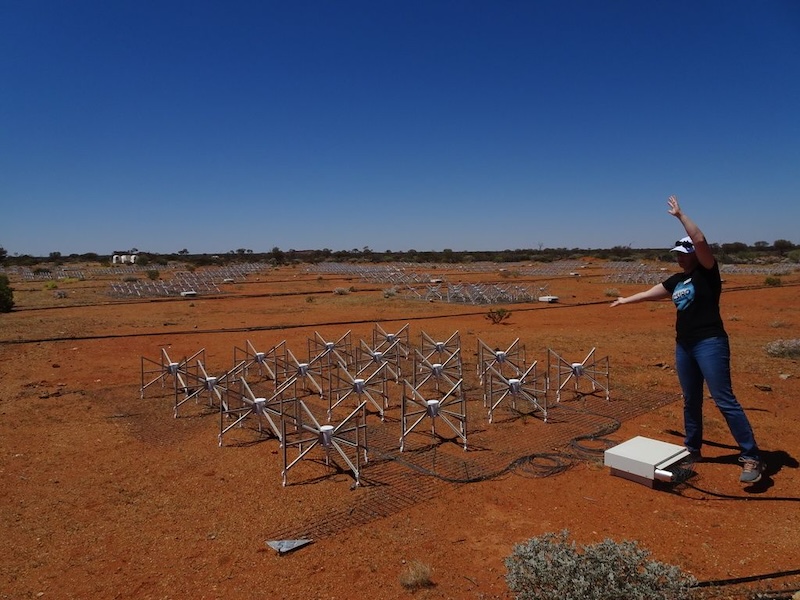[ad_1]

- SETI is the search for extraterrestrial intelligence. It’s looking for signals from intelligent life on other worlds, or for signs of their structures.
- A new search of 2,800 distant galaxies by astronomers in Australia is the first of its kind. To date, astronomers have searched mostly among stars in our own galaxy.
- Alien civilizations more advanced than us, these researchers say, could transmit signals or harness enough energy to be detectable across galactic distances.
Searching for extraterrestrial intelligence
The search for extraterrestrial intelligence, or SETI, is about looking for artificial radio signals from alien worlds. Or it might mean searching for other sorts of technosignatures, other signs of past or present technologies. And, so far, the search has concentrated mainly on stars in our home galaxy, the Milky Way. But now a new initiative has carried the search for intelligent aliens to other galaxies. It’s the first search of its kind for alien intelligence, with 2,800 galaxies scanned.
On August 26, 2024, the SETI Institute, the Berkeley SETI Research Center and the International Centre for Radio Astronomy Research announced their new extragalactic SETI search. They said they used the Murchison Widefield Array (MWA) in Western Australia to scan the galaxies.
The researchers published a preprint version of their new paper on arXiv on August 19, 2024.
SETI observes 2,800 galaxies at once
These researchers were able to conduct their search using the large field of view (the circle of sky visible through the eyepiece) on the Murchison Widefield Array. The large field of view let them observe 2,800 galaxies at one time. They focused primarily on the approximately 1,300 of those galaxies that have known distances. In addition, the search also focused on low radio frequencies (100 MHz), for which the Murchison Widefield Array is well-suited. As the scientists’ paper said:
It is common for surveys that are designed to find artificial signals generated by distant civilizations to focus on galactic sources. Recently, researchers have started focusing on searching for all other sources within the field observed, including the vast population of background galaxies.
Toward a population of galaxies in the background toward the Vela supernova remnant, we search for technosignatures, spectral and temporal features consistent with our understanding of technology.
Of these galaxies, we focus on the 1,317 sources that have known redshifts, since these can be used to estimate distances, and hence transmitter power requirements.
Chenoa Tremblay of the SETI Institute is one of the two lead researchers. She said:
This work represents a significant step forward in our efforts to detect signals from advanced extraterrestrial civilizations. The large field of view and low-frequency range of the MWA makes it an ideal tool for this kind of research, and the limits we set will guide future studies.

Super civilizations
The signals that the study looked for are a specific type of technosignature. Basically, a technosignature is any kind of sign of advanced alien technology. It could be radio signals, laser/light signals or Dyson spheres and other artificial structures. It could even be artificial pollution in a planet’s atmosphere. Notably, any alien civilizations that this kind of search might detect in other galaxies would be more advanced than us. In essence, supercivilizations. Since the galaxies are so incredibly distant, any signal would need to be powerful. In fact, it would require technology powerful enough to use the energy of their sun or even other stars in their galaxy. The paper elaborated on this, saying:
It is generally agreed upon supercivilizations to harness the energy from natural objects and transmit signals over large distances. Haliki (2019) and Chennamangalam et al. (2015) created a model where pulsars, rapidly spinning neutron stars, could be used as modulated signal beacons to contact other civilizations. Their recommendation was that Type III civilizations could not only use the beacons of light and change the modulation for communication but could potentially create an entire communication network. As modern radio telescopes can detect pulsars in galaxies external to our own, it offers another potential mechanism for generating emission, although broadband (frequency width over MHz) in nature; we could potentially detect the resultant energy from the technology.
No signals found, yet
In this case, the search didn’t find any signals or other technosignatures. But it is only the first search of its kind. The paper said:
Although no signals were detected, we have placed stringent limits on the transmitter power over the 1,317 galaxies on the order of 1022 W. Kardashev (1985) suggests that large-scale technology would have a lot of mass, a large energy potential and a high information volume. With the sensitivity of modern radio telescopes, it may be possible to detect radiation coming from such a supercivilization even at galactic distances.
Indeed, the study presents a novel new way to conduct future searches. As co-lead author, Steven Tingay of Curtin University, noted:
The MWA continues to open up new ways of exploring the Universe for intelligent civilizations and technosignatures, while using the same data to study the astrophysics of stars and galaxies. This work is new and novel, but also paves the way for future observations with even more powerful telescopes.
Bottom line: A new SETI search for extraterrestrial intelligence, by astronomers in Australia, is the first of its kind. It looked for technosignatures in distant galaxies.
Source: An Extragalactic Widefield Search for Technosignatures with the Murchison Widefield Array
Via SETI Institute
Read more: SETI looks to Milky Way’s heart for alien signals
Read more: Will SETI 2.0 lead to a discovery of intelligent aliens?
[ad_2]
Source link





No comments! Be the first commenter?